Cameras for nursing homes are indispensable tools for maintaining safety and security, offering real-time monitoring, prompt issue detection, and transparency for families. High-quality fixed, wireless, and thermal imaging cameras capture detailed footage, aiding in trend identification, staff assessment, and regulatory adherence. While implementing cameras for nursing homes requires balancing security with privacy, strict protocols can ensure informed consent, secure data handling, and respectful monitoring, fostering enhanced care while preserving dignity. Effective systems provide comprehensive coverage, remote access via mobile devices, regular maintenance, and staff training, ultimately promoting better care, improved communication, and higher resident satisfaction.
Surveillance systems in nursing homes have become a vital tool for ensuring resident safety, enhancing care quality, and promoting overall well-being. With increasing concerns about elder abuse, neglect, and falls, implementing effective monitoring is essential. This article explores the significance of surveillance in nursing homes, delves into different camera types suitable for this setting, discusses ethical considerations regarding privacy, and provides a guide to successful implementation and maintenance. Discover how cameras for nursing homes can contribute to improved care and peace of mind.
Understanding the Importance of Surveillance in Nursing Homes
Surveillance in nursing homes plays a pivotal role in ensuring the safety, security, and well-being of residents. In today’s digital era, cameras for nursing homes have become indispensable tools for monitoring and documenting various aspects of care. These devices enable staff to maintain a constant watch over residents’ activities, detecting potential issues promptly and facilitating swift interventions when needed.
Moreover, surveillance systems offer peace of mind for families and caregivers by providing transparency into the daily lives of their loved ones. High-quality cameras installed in strategic locations can capture detailed footage, helping to identify trends, assess staff performance, and ensure adherence to regulatory standards. By leveraging technology in this manner, nursing homes can foster a safer environment while promoting effective care practices.
Types of Cameras for Nursing Home Monitoring
Surveillance in nursing homes has evolved significantly with advancements in technology, particularly through the use of cameras for nursing homes. These systems play a crucial role in ensuring the safety and well-being of residents while providing staff with valuable insights into day-to-day operations. The most common types of cameras include fixed cameras, which offer continuous monitoring of specific areas like hallways, activity rooms, and dining spaces.
For more dynamic coverage, wireless cameras and IP cameras are increasingly popular. These can be strategically placed indoors and outdoors to capture a broader view of the nursing home environment. Additionally, thermal imaging cameras can detect heat signatures, helping to identify residents who may be in distress or need immediate attention. This technology contributes to a comprehensive cameras for nursing homes surveillance system that promotes better care and peace of mind for both residents and their families.
Ethical Considerations and Privacy Concerns
The implementation of surveillance systems in nursing homes, equipped with cameras for nursing homes, raises significant ethical considerations and privacy concerns. While enhancing security and safety is a valid objective, it must be balanced against the residents’ right to privacy and dignity. The use of cameras should be restricted to common areas and essential for the well-being of patients, ensuring that their living spaces remain free from constant surveillance.
Residents and their families must be informed about the presence of cameras, the purpose of their installation, and who has access to the footage. Transparent practices ensure trust and respect for individual privacy. Moreover, strict protocols should be in place to safeguard personal data, including secure storage, limited distribution, and regular reviews to prevent unauthorized access or misuse.
Implementing and Maintaining an Effective Surveillance System
Implementing and maintaining an effective surveillance system in nursing homes is paramount to ensuring resident safety and well-being. Cameras for nursing homes play a pivotal role in achieving this, providing real-time visibility and peace of mind for both staff and families. The choice of camera technology should consider factors like resolution, field of view, and night vision capabilities, all tailored to the unique needs and layouts of the facility. A well-designed system offers comprehensive coverage, capturing key areas such as common spaces, corridors, and resident rooms, while also allowing for remote monitoring via mobile devices.
Regular maintenance is crucial to keep cameras for nursing homes functioning optimally. This includes routine checks for technical glitches, ensuring clear audio and video quality, and promptly addressing any issues that may compromise the system’s integrity. Additionally, staff training on operating and managing the surveillance equipment is essential. By integrating these practices, nursing homes can create a secure environment that promotes better care, improves communication, and enhances overall resident satisfaction.
